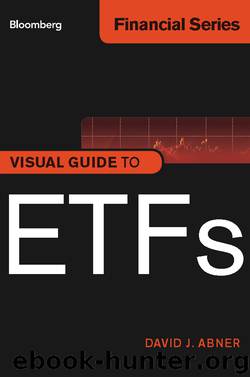Visual Guide to ETFs by David J. Abner

Author:David J. Abner [Abner, David J.]
Language: eng
Format: epub
ISBN: 978-1-118-23158-6
Publisher: Wiley
Published: 2013-03-23T16:00:00+00:00
Closer Look at the SEC-CFTC Report Findings
Some very important features of the September 30, 2010, SEC report can shed some further light on what happened regarding ETFs. On page 39 of the report, we read, “A large majority of ETF market makers with whom we spoke, and particularly those that value underlying stocks as part of their normal market making activities, paused their market making for considerable periods of time starting at 2:45 P.M on May 6. We believe that this is one of the reasons equity-based ETFs were disproportionately affected by the extreme price volatilities of that afternoon.”4
One notable aspect of what happened is described at the very beginning of the report. On page 4, as part of the executive summary, the report describes trading pauses undertaken by many automated trading systems in response to extreme and sudden price declines.
A trading pause is a logical function embedded into an automated trading system to allow participants to assess market situations. “Participants reported that these assessments include the following factors: whether observed severe price moves could be an artifact of erroneous data; the impact of such moves on risk and position limits; impacts on intraday profit and loss (P&L); the potential for trades to be broken, leaving their firms inadvertently long or short on one side of the market; and the ability of their systems to handle the very high volume of trades and orders they were processing that day.”5 There can be either data integrity pauses, based around price moves, or feed-driven integrity pauses, based around quote latency, that will cause a trading system to stop trading to determine whether the calculated fair value is reasonable before continuing to trade.
It is also important to understand the use of what are termed stub quotes in this context and how they relate to a pause in market-making activities. On page 38 of the same report, we read, “In order to comply with their obligation to maintain continuous two-sided quotations, market makers utilize stub quotes if they choose to discontinue actively quoting.”6 Thus, on May 6, while in the process of reassessing whether to reenter the market, some market maker quotations had extended to stub quote spreads; for market makers on NASDAQ or NYSE Arca, such stub quotes could be automatically generated upon a market maker’s withdrawal from the market. When a market maker is unable to determine a fair value for an ETF because of some form of system or quoting issue, they may step back from their inside quote to assess the market. Their system can automatically generate a stub quote (not intended to be traded against) while they are developing a valid fair value for the ETF. They are still, technically, making a market in a security and fulfilling their obligation, but the bid and offer is so unreasonably wide that no one would normally trade there.
The Timetable of What Happened on May 6, 2010
2:05 p.m. On May 6, 2010, due to increasingly violent protests in Athens over the Greek debt crisis, the euro fell sharply.
Download
This site does not store any files on its server. We only index and link to content provided by other sites. Please contact the content providers to delete copyright contents if any and email us, we'll remove relevant links or contents immediately.
The Black Swan by Nassim Nicholas Taleb(6762)
Bad Blood by John Carreyrou(6274)
Pioneering Portfolio Management by David F. Swensen(6078)
Millionaire: The Philanderer, Gambler, and Duelist Who Invented Modern Finance by Janet Gleeson(4093)
Skin in the Game by Nassim Nicholas Taleb(3965)
The Money Culture by Michael Lewis(3846)
Bullshit Jobs by David Graeber(3828)
Skin in the Game: Hidden Asymmetries in Daily Life by Nassim Nicholas Taleb(3720)
The Wisdom of Finance by Mihir Desai(3523)
Blockchain Basics by Daniel Drescher(3329)
Liar's Poker by Michael Lewis(3220)
The Intelligent Investor by Benjamin Graham Jason Zweig(2930)
Hands-On Machine Learning for Algorithmic Trading by Stefan Jansen(2925)
Mastering Bitcoin: Programming the Open Blockchain by Andreas M. Antonopoulos(2891)
Fooled by Randomness: The Hidden Role of Chance in Life and in the Markets by Nassim Nicholas Taleb(2860)
Investing For Dummies by Eric Tyson(2793)
The Power of Broke by Daymond John(2770)
Market Wizards by Jack D. Schwager(2538)
Zero Hour by Harry S. Dent Jr. & Andrew Pancholi(2531)
